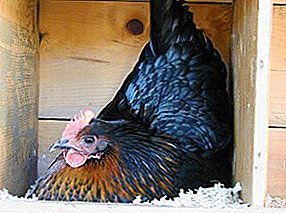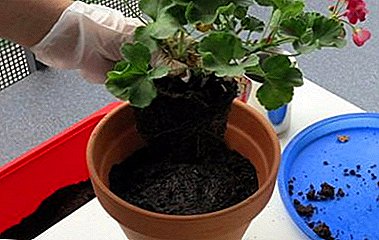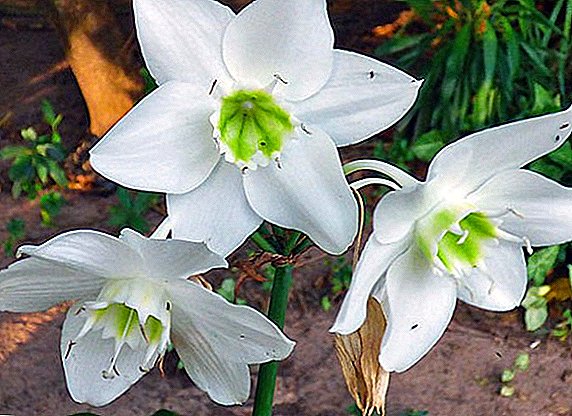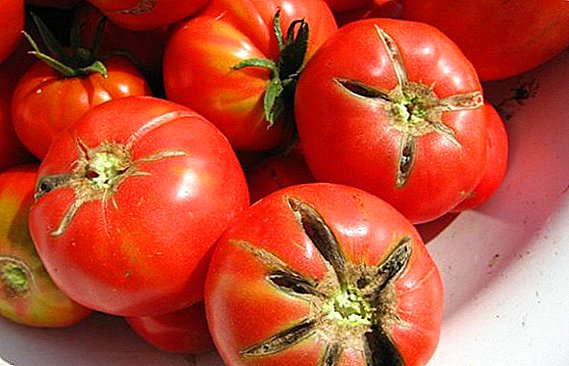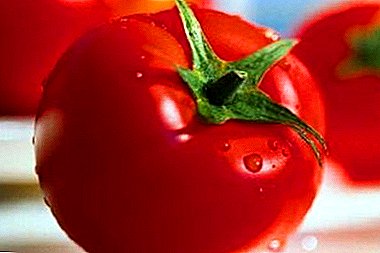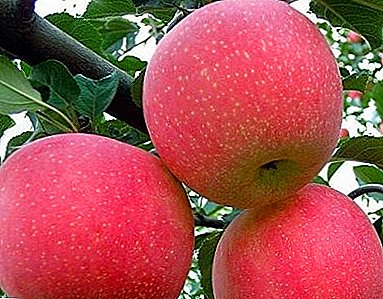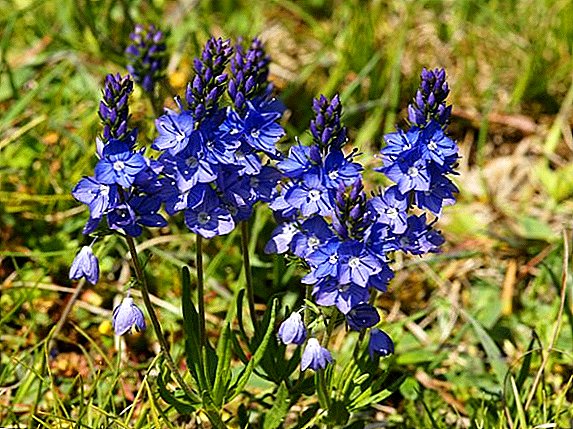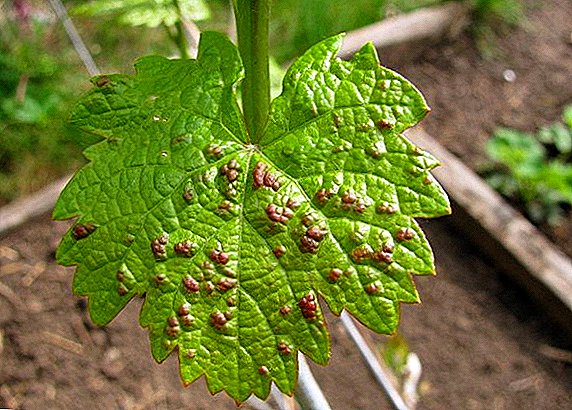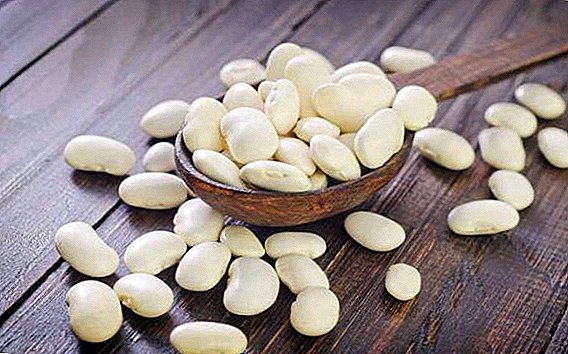 After the white beans were first imported into Russia, it was not immediately used in cooking. At first, this plant was considered only for decorative purposes, but after a time, when it turned out that the beans were very easy to grow and it was perfect for human consumption, they began to be used everywhere. And not in vain, because this culture has many useful properties, is a dietary product and has a high energy value.
After the white beans were first imported into Russia, it was not immediately used in cooking. At first, this plant was considered only for decorative purposes, but after a time, when it turned out that the beans were very easy to grow and it was perfect for human consumption, they began to be used everywhere. And not in vain, because this culture has many useful properties, is a dietary product and has a high energy value.
Description
White beans are a plant belonging to the legume family. Annual, climbing or artisanal, some varieties of which sometimes reach almost 3 meters in length.
Elegant flowers, which are covered with a stem, form hanging bivalve pods. Each such pod contains from two to eight beans.
Beans have a traditional shape in the form of a crescent oblate from the sides, but small varieties have a dense structure and regular oval shape. The color of the beans is usually milky white. Beans are covered with a smooth, glossy rind, which has a tendency to shrink during soaking. 
Other representatives of legumes are also beneficial for the body: peanuts, peas, asparagus, mouse peas.
Since this is a thermophilic culture, the beans are planted in the soil in late May or early June. And from the time the first sprouts sprout to the technical maturity of the fruits, it takes about 65 days, sometimes less, depending on the variety. Harvesting often falls at the end of July or the beginning of August.
This plant has many beneficial properties, has a rich vitamin and mineral composition, has a good taste and is even able to act as a support for the main therapy for many diseases.
Did you know? Napoleon Bonaparte was famous for his love of beans. He believed that this miraculous product can increase the number of thoughts in the head and the strength in the muscles.Beans are:
- a dish of vegetarians, as it contains a lot of vegetable protein;
- a dish of those who want to lose weight and is on a diet, since this legume culture helps to cleanse the body of excess fluid and toxins;
- athletes and those who deal with hard physical labor, as it contains a lot of carbohydrates;
- as well as this vegetable is suitable for those who have various health problems - suffering from diseases of the heart and blood vessels, liver, pancreas and kidneys.

Composition
The nutritional value per 100 grams of white beans is about 300 kcal, of which:
- carbohydrates - 47 g (~ 188 kcal);
- proteins - 21 g (~ 84 kcal);
- fat - 2 g (~ 18 kcal).
Learn more about other types and varieties of green beans.In addition, the bean contains such elements as:
- starch - 43.8 g;
- water - 14 g;
- dietary fiber - 12.4 g;
- ash - 3.6 g;
- mono - and disaccharides - 3.2 g;
- saturated fatty acids - 0.2 g.
 Besides, white beans are rich in such vitamins:
Besides, white beans are rich in such vitamins: - Vitamin PP NE (niacin equivalent) - 6.4 mg;
- vitamin PP (niacin) - 2.1 mg;
- Vitamin B5 (pantothenic acid) - 1.2 mg;
- Vitamin B6 (pyridoxine) - 0.9 mg;
- vitamin E (tocopherol) - 0.6 mg;
- Vitamin B1 (thiamine) - 0.5 mg;
- vitamin B2 (riboflavin) - 0.18 mg;
- Vitamin B9 (folic acid) - 90 mg.
Important! The amount of folic acid in white beans is 91% of the daily human need. Therefore, this product is recommended for use by pregnant women, as they have an increased need for folic acid.The composition of this product also includes macronutrients:
- potassium - 1100 mg;
- phosphorus - 480 mg;
- sulfur - 159 mg;
- calcium - 150 mg;
- magnesium - 103 mg;
- silicon - 92 mg;
- chlorine - 58 mg;
- sodium - 40 mg.
 And trace elements:
And trace elements:- iron - 5.9 mg;
- zinc - 3.21 mg;
- manganese - 1.34 mg;
- aluminum - 640 mcg;
- copper - 580 mcg;
- boron - 490 mcg;
- Nickel - 173.2 mcg;
- vanadium - 190 mcg;
- titanium - 150 mcg;
- fluorine - 44 mcg;
- molybdenum - 39.4 mcg;
- selenium - 24.9 mcg;
- cobalt - 18.7 mcg;
- iodine - 12.1 mcg;
- chromium - 10 µg.
Beneficial features
The vegetable protein contained in white beans resembles beef and is of high quality, while it does not contain animal fat, which hampers the work of the gastrointestinal tract. A large amount of indigestible dietary fiber (cellulose) normalizes digestion, regulates stool and helps to toxins, slags and various harmful substances successfully excreted from the body.
Not less useful properties and asparagus beans.
 White beans reduce cholesterol, strengthens the bone, cardiovascular system, normalizes the flow of nerve processes, reduces blood sugar levels and has a general strengthening and healing effect.
White beans reduce cholesterol, strengthens the bone, cardiovascular system, normalizes the flow of nerve processes, reduces blood sugar levels and has a general strengthening and healing effect.
Ginger, leeks, amaranth thrown back, tomatoes, cilantro, calendula will help lower cholesterol.
The use of this product is recommended for diabetes mellitus, as due to its rich composition it is able to normalize blood glucose levels, reduce sugar, improve the condition of a sick person. The chemical composition of beans is unique and equates to insulin in its effects, which makes this type of legume an indispensable product in the diet of diabetics.
In addition, these legumes effectively regulate the work of the heart and blood vessels, lower the pressure and strengthen the cardiovascular system, which is very important for people with diabetes.
Important! White beans contribute to maintaining the whiteness of the teeth. It strengthens the gums and enamel, retains the natural color of the teeth, and this is the only type of beans that are part of the "white diet", which is followed by those who have undergone the teeth whitening procedure.With this disease, this type of legumes can be eaten simply in the form of soups, as part of salads or as an independent dish. The product is combined with both meat and vegetables.
For example, a bean soup-puree can taste like a diabetic. To make it you need to take:
- 400 g white beans;
- one onion;
- one clove of garlic;
- 1 boiled egg;
- 200 g of cauliflower;
- a couple tablespoons of vegetable broth;
- 1 tablespoon of vegetable oil;
- salt, parsley and dill to taste.
 Onions and garlic should be stewed until onions are soft. Next, add vegetable broth, beans and finely chopped cauliflower, and boil all this for 20 minutes. At the end of cooking, the finished mixture is poured into a blender and chopped brew until a smooth mash, and then returned to the saucepan. Add spices and salt, and boil for another couple of minutes. Served with a finely chopped boiled egg and decorated with parsley leaves.
Onions and garlic should be stewed until onions are soft. Next, add vegetable broth, beans and finely chopped cauliflower, and boil all this for 20 minutes. At the end of cooking, the finished mixture is poured into a blender and chopped brew until a smooth mash, and then returned to the saucepan. Add spices and salt, and boil for another couple of minutes. Served with a finely chopped boiled egg and decorated with parsley leaves. 
Important! The use of undercooked beans is unacceptable, as raw beans contain phasin, which is a poison and causes severe poisoning.In addition to the clear benefits for diabetics, white beans also:
- strengthens bones, improves the condition of teeth and is able to prevent osteoporosis, as it contains a large amount of calcium;
- enhances immunity due to the rich vitamin composition;
- useful for the heart and blood vessels, makes the heart muscle more elastic and resilient, regulates vascular tone;
- contributes to blood formation due to easily digestible iron, stimulating the production of red blood cells - blood cells, therefore, is indispensable for anemia (anemia);
- during pregnancy it almost completely meets the daily need for folic acid, which is indispensable for a developing fetus;
- cleanses the body of toxins and toxins, and also strengthens the liver and kidneys, because of which they better cope with the filtering function;
- contributes to a more rapid recovery of the body after various injuries, operations;
- supports the nervous system, normalizing its work during acute or chronic stress;
- helps to remove stones from the kidneys and gall bladder;
- improves the appearance of nails, hair and skin;
- enhances the production of gastric juice and normalizes the body's metabolic processes;
- able to normalize the potency in men due to pyridoxine and folic acid, which improve spermatogenesis and affect the duration of sexual intercourse;
- normalizes the functioning of the female reproductive system due to arginine in the composition of the product.
 Canned white beans differ from other forms of cooking in that they contain an even smaller amount of calories: there are only about 99 kcal per 100 grams of product, of which:
Canned white beans differ from other forms of cooking in that they contain an even smaller amount of calories: there are only about 99 kcal per 100 grams of product, of which:- carbohydrate - 17.4 g (~ 70 kcal);
- proteins - 6.7 g (~ 27 kcal);
- fat - 0.3 g (~ 3 kcal).
Harm and contraindications
Excessive consumption of white beans can lead to some negative consequences - heaviness in the stomach and increased gas formation.
Besides There are a number of contraindications to the use of this product. These include diseases such as:
- gastritis with a high level of acidity (with low acidity to eat beans is permissible, as it increases the formation of acid);
- peptic ulcer of the stomach, especially in the period of exacerbation;
- cholecystitis;
- colitis;
- pancreatitis;
- gout.
 Some people may experience individual intolerance to beans, which is manifested by allergic reactions. In this case, its use in food is also unacceptable.
Some people may experience individual intolerance to beans, which is manifested by allergic reactions. In this case, its use in food is also unacceptable.Important! To avoid excessive gas formation and facilitate digestion, white beans are best not to combine with flour products and bread. Otherwise, the body will be hard to cope with excess fiber. It is best to combine these legumes with meat and vegetables.
Application in cosmetology
White beans are widely used in home cosmetology. It is used to make various face masks that are absolutely suitable for all skin types.
Recipes harvesting asparagus beans for the winter.
These legumes effectively whiten the skin, nourish and saturate it with useful substances, have a rejuvenating effect, as they have the property of lifting, and also cleanse the skin of black spots, acne, irritations, remove bruises and bags under the eyes.
In order to make a face mask, you must first boil the kernels until ready and cool. Then sift them through a sieve so that a homogeneous and soft mash, devoid of hard skin and lumps, remains.  We knead with a fork and add various ingredients, for example:
We knead with a fork and add various ingredients, for example:
- olive oil and lemon juice to tone and refresh the skin;
- mashed sour apples, egg, oatmeal and cream for lifting;
- sea salt to improve the elasticity of the skin.
Did you know? Beautiful Cleopatra used white for the face, made from powdered dried white beans and a small amount of warm water. This powder completely covered the face and filled all the wrinkles, making the skin radiant, smooth and young. Why, only when the skin dried up, such a mask was covered with cracks.
How to choose
Choosing a product, you first need to pay attention to its condition - it should not be damaged, it should not be mold, rot or signs of clumping.
The beans must be intact and of equal size. The peel on the beans should be smooth and shiny. 
How to store
If you grow beans yourself, then when harvesting for the winter should follow some rules:
- after you have half the grain, it is necessary to warm them in the oven or on the pan for three minutes;
- but the young seeds in the pods can be simply frozen.
The shelf life of the product in this form can not exceed 6 months.
Check out the recipe for cooking beans in tomato sauce.
But for the storage of dry product, well-dried beans are placed in a glass container (jar) and tightly closed with a plastic lid. The jar is placed in a dry and dark place where there is good ventilation and room temperature is maintained.
In no case should not allow the penetration of moisture and insects to the product. You can store beans for 1 year.  Thus, the beans must be present in the diet, as evidenced by its rich vitamin and mineral composition. In addition, its beneficial properties not only improve the body from the inside, but also help to look fresh.
Thus, the beans must be present in the diet, as evidenced by its rich vitamin and mineral composition. In addition, its beneficial properties not only improve the body from the inside, but also help to look fresh.


